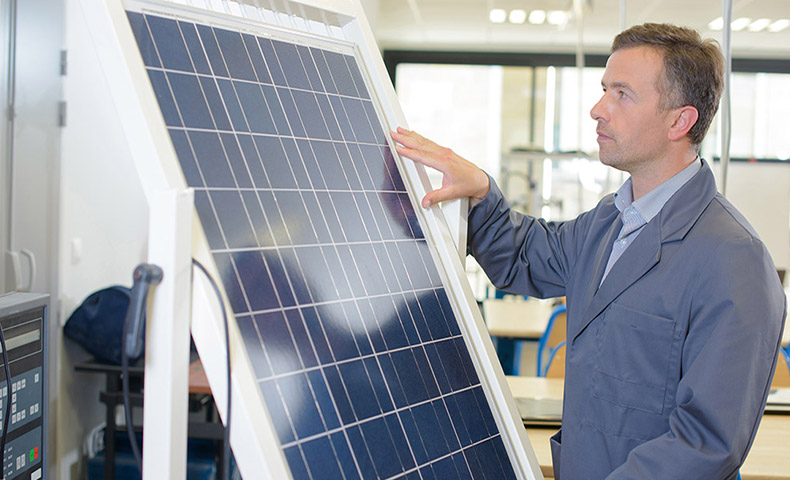
Earlier this week, the Korean manufacturer Hanwha Q-Cells Co. announced the launch of its new product, the Q.Peak Duo-G6, a half-cell monocrystalline solar panel.
The module is produced with larger wafers, which is said to increase module yield by around 6%.
Also, unlike regular 60-cell and 72-cell modules, these ones come in a 122-cell format with an output of 355 W and in a 144-cell version, which Hanwha says ensures an output of 420 W. The panels are still in the same size, only the cells have shrunk.
This larger solar cell feature is achieved by cutting them in half. But why?
As photovoltaic technology advances, new innovations come into being and one of those is half-cell modules.
In regular silicon cell-based PV modules, the ribbons interconnecting adjacent cells can cause a significant loss of power as it flows from one cell to the next. Cutting solar cells in half with laser technology has proven to be an effective way to lower this power loss.
A study conducted by the Institute for Solar Energy Research Hamelin in Germany broke the previous record for module efficiency and peak power output through this type of modules.
“By using half-cell design the current of the cell strings is reduced resulting in a significant reduction of the series resistance losses. The distance of the cells is reduced to a practical minimum to increase the module efficiency,” the researchers noted.
Why this matters to homeowners and businesses is obvious. Despite reductions in costs over the last decade, solar panels still constitute roughly 45 percent of the total cost of a solar power system (experts expect this to fall to 29 percent by 2027).
Increasing the power output of a solar module means you need fewer ones on your roof to reach your energy needs.
To find out how much it would be to cover the equipment and installation of a solar system for your home, you can get a fast, easy quote through the Hahasmart price checker that gives you this information in seconds by simply using your address and average monthly utility bill.
For large scale utility plants, lesser space requirements can help reduce the land required for setting up solar farms. In turn, this can help reduce capital expenditure costs for solar power developers as land is an expensive input cost involved in setting up of large scale land-based solar power plants.
Less Shading Impact
Another advantage of half-cut cells is that they have been proven to perform better in certain shading situations, for instance, if the lower part of an installation in portrait orientation lies in shadow. Shade of any kind can reduce the energy output of a solar panel significantly.
In fact, that’s one of the features of the new half-cell modules announced by Q-Cells. The manufacturer notes the G6 has optimized shading behavior as its upper and lower sides, which are susceptible to shading in strings of modules installed too close together, can operate independently from other parts of the panel.
In addition, smaller cells experience reduced mechanical stresses, so there is a decreased opportunity for cracking. And half-cell modules are also more reliable than traditional panels. Some studies show that half cut cells are more resistant to the effects of heat and so won’t suffer as much of a decrease in efficiency when they get hot. And solar modules do get hot if they have been installed properly, as they’re outside under the sun, converting sunlight into electricity. A solar module in bright sunshine will become 86°F hotter than the ambient temperature. If that could be restricted to 68-77°F, power output and module life would be extended.
They are also said to be long-lasting. Hanwha Q Cells claims the G6 can maintain more than 85% of its initial performance after 25 years.
All of this makes these cells highly attractive to buyers. The International Technology Roadmap for Photovoltaic (ITRPV) predicts the market share of half cells will grow from 5% in 2018 to nearly 40% in 2028.
Needless to say, Hanwha Q Cells is not the only player in this game. Longi Solar, Trina Solar and other brands are following suit.
But with advantages also come some drawbacks.
Being that they’re the new trend, they have a higher cost. And because they have additional cells, there is twice the potential for soldering or internal cell defects.
After all, laser-cutting the cell down the middle without cracking it is a delicate process. Half-cells often use four or more busbars. Stringing these very narrow connection strips across a smaller footprint requires the use of precise equipment. Junction boxes are also different on half-cell modules. Most brands use multiple, smaller junction boxes so each module half can function as its own. Otherwise, half-cell module assembly is like full-cell production.
HahaSmart Blog - More Solar Tips and Guide
HahaSmart News - Stay Informed
Your Solar Incentives - See Credits and Incentives in Your Area
Check Your Home's Solar Price - See How Much You Save
Register Now - Unlock The Lowest Solar Prices in Your Area


Input your address to see if it is solar friendly and how much you can save with solar.
Great. Your address is perfect for solar. Solar incentive is still available. Select monthly utility cost and calculate the size of solar system you will need now.
| kw System size | years Payback period | Lifetime savings |
No money down, 100% finance is available.
|
|
Check the price of solar panels in your area in a matter of seconds! |
Comments